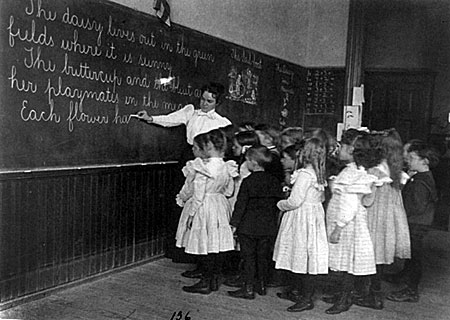Public Education
The growing foreign-born immigrant population and the demand for a technically skilled workforce created the need for expanded educational opportunities. By 1900, many states had compulsory education attendance requirements where children between the ages of eight and fourteen were required to attend public school. Urban areas had better funded schools than rural areas and whites had better educational opportunities than African Americans.
 School children in the late 1800s |
Many immigrants had come from cultures that placed a high value on education. Children attended free public school to learn to read and write and assimilate into an American culture that placed high value on patriotism and the hard work of the individual. Most African-American children attended segregated schools with inadequate books, equipment, and other resources. Some immigrants could afford for their children to attend private schools that preserved their cultural traditions and language.
In response to industrialization, higher education in science and technology expanded for those who could afford it. Between 1870 and 1900, more than 250 colleges and universities opened in the United States. Many were funded with money from wealthy industrialists like Cornelius Vanderbilt and John D. Rockefeller. Federal land grant institutions were also established to advance knowledge in agriculture and agricultural technology.
At the end of the Civil War, very few colleges were coeducational. Private women’s colleges that served as sister schools to their male counterparts were established as women demanded greater access to higher educational opportunities. Radcliffe, the sister school to Harvard in Massachusetts, and Barnard, the sister school to Columbia in New York, were established in 1879 and 1889 respectively. Other women’s colleges like Mount Holyoke, Vassar, Smith, and Wellesley were also established in the 1880s. Women’s colleges played an important role in the changing position of women who were becoming more than wives and mothers.